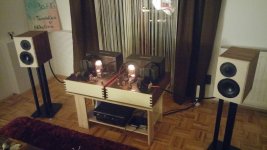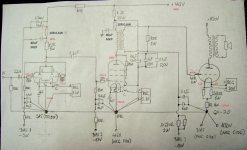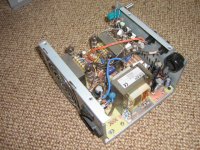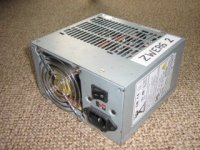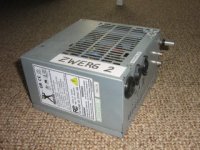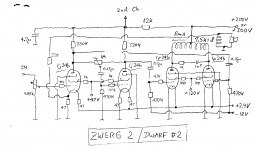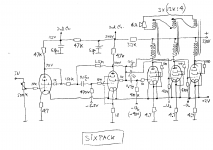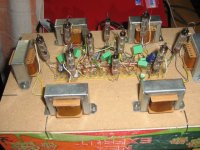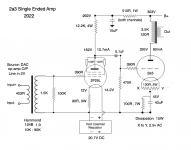The kind of directly heated tubes nobody is talking about are Russian rod pentodes. These tubes have super efficient filaments that can be practically run on one or two NiCd batteries, making clumsy DC filament supplies unnecessary.
I actually built two "power" amps with these:
Zwerg 2 (Dwarf #2):
- push-pull- all pentode DHT - Gnfb - 100 V line transformer OPT 7.5k / 8 8hm
- 8 rod tubes (2 x 1j24b + 2 x 1p24b per channel)
- 2 x 4 W output into 8 ohm - 30 W input from mains
- fits into a small atx power supply box incl p.s., iec mains connector & switch
- 15 x 14 x 8.5 cm^3 or 5 7/8 x 5 1/8 x 3 1/3 inch^3
- 1.8 kg or 4 lb
SixPack:
- single ended all triode DHT - no GFB - triple Telefunken OPT 12k / 4 ohm
- primaries in parallel, secondaries in series, 6k / 6 ohms per output tube
- why ? because I have a box full of these small transformers
- 10 rod tubes (1 x 1j18b + 1x 1j29b + 3 x 1p24b per channel)
- 2 W output into 6 ohm per channel (plan to double by paralleling outputs)
- p.s. currently 12V notebook brick into 2V buck SMPS and 270V boost conv
- prototype on fruit crest
Both perform well within their limits.
I am working on schematics and pictures ... soon ...
Zwerg 2 (Dwarf #2):
- push-pull- all pentode DHT - Gnfb - 100 V line transformer OPT 7.5k / 8 8hm
- 8 rod tubes (2 x 1j24b + 2 x 1p24b per channel)
- 2 x 4 W output into 8 ohm - 30 W input from mains
- fits into a small atx power supply box incl p.s., iec mains connector & switch
- 15 x 14 x 8.5 cm^3 or 5 7/8 x 5 1/8 x 3 1/3 inch^3
- 1.8 kg or 4 lb
Attachments
SixPack:
- single ended all triode DHT - no GFB - triple Telefunken OPT 12k / 4 ohm
- primaries in parallel, secondaries in series, 6k / 6 ohms per output tube
- why ? because I have a box full of these small transformers
- 10 rod tubes (1 x 1j18b + 1x 1j29b + 3 x 1p24b per channel)
- 2 W output into 6 ohm per channel (plan to double by paralleling outputs)
- p.s. currently 12V notebook brick into 2V buck SMPS and 270V boost conv
- prototype on fruit crest
Attachments
Windcrest- did you actually build that 112A > 45 amp? I'm interested to know how the LL1660 worked in 2:4.5. I have a couple of LL1660 and could try that if it works. This would be into a 2a3 output.
I didn't build that one, just beginning to experiment with DHT's so your post was a good timing to go hunt my schematics. I do like that schematic though for a headphone Amp, I received 5K:40R OPT's from Electra print a year ago with the plan to make a 45 HPA. I had him wind the secondary to 40R then I'd use a rotary switch to LPad pairs of attenuating and shunt resistors for low, med, or high impedance phones. This one looks like you might be able to tube roll 26, 31, 56, 112, etc. no? The thought of a 45 HPA has always been something I wanted to do.
Out of all the DHT tubes I've tried I'd put 10Y and 46 tied for best sound, 10Y more euphonic, 46 more neutral. Close behind with about 90% of he sound I'd put the 2P29L, which is much, much easier to build with and very cheap and available. So that's my go-to DHT.
4P1L is a bit thin in the midrange to my ears, though with excellent treble, bass and dynamics. Just something a trifle not right, and has to be used at 25-30mA or more. The 2P29L is smoother and works fine at lower currents. The 26 is an excellent tube, though I find it a bit warm after the neutrality of the 2P29L and I prefer not to use a 1 amp filament if possible. 112A is another possibility which I haven't tried recently. 01A is too low current, though it could maybe be tried at 6mA or so - datasheet has no max dissipation for the tube so it's guesswork. Don't have 71A any more, but I don't remember it being better than the above. 47 isn't as good as 46, probably on a par with 2P29L. Haven't tried 45. 300B sounds poor to me in a preamp stage, 6C4C much better and very dynamic. Better then 300b as an output too, like 2a3. Several other DHTs weren't as good as the above and got sold - 30, 31, 30SP, 1G4, 3a5... can't remember them all. I didn't try the expensive European tubes like PX25, PX4, AD1 and so forth. There were also some interesting Philips tubes like 4606, 4609, 4613, 4617, 4630, 4683 but far too rare to invest in and I never had any.
For most uses 2P29L in filament bias gets my vote. If you want to go a little better, then 10Y or 46. 10Y fairly easy to use in filament bias, 46 much more difficult, so the 10Y is more of a go-to option all round.
4P1L is a bit thin in the midrange to my ears, though with excellent treble, bass and dynamics. Just something a trifle not right, and has to be used at 25-30mA or more. The 2P29L is smoother and works fine at lower currents. The 26 is an excellent tube, though I find it a bit warm after the neutrality of the 2P29L and I prefer not to use a 1 amp filament if possible. 112A is another possibility which I haven't tried recently. 01A is too low current, though it could maybe be tried at 6mA or so - datasheet has no max dissipation for the tube so it's guesswork. Don't have 71A any more, but I don't remember it being better than the above. 47 isn't as good as 46, probably on a par with 2P29L. Haven't tried 45. 300B sounds poor to me in a preamp stage, 6C4C much better and very dynamic. Better then 300b as an output too, like 2a3. Several other DHTs weren't as good as the above and got sold - 30, 31, 30SP, 1G4, 3a5... can't remember them all. I didn't try the expensive European tubes like PX25, PX4, AD1 and so forth. There were also some interesting Philips tubes like 4606, 4609, 4613, 4617, 4630, 4683 but far too rare to invest in and I never had any.
For most uses 2P29L in filament bias gets my vote. If you want to go a little better, then 10Y or 46. 10Y fairly easy to use in filament bias, 46 much more difficult, so the 10Y is more of a go-to option all round.
Wonderful responses! More schematics than I could imagine. This has certainly opened my eyes.
The circuits are mostly divided between 3 stage designs and 2 stage designs with an input transformer or an interstage step-up. So I decided to do a test of the differences between these choices. So I did an A-B listening test with these alternatives. Same music, same 2A3 SE output stage, just changed the input stage.
1. SUT Hammond 124B 1:3 into 2P29L in filament bias.
2. 10Y stage replaces the SUT into the same 2P29L stage.
Well, my hunch was that the SUT would sound better, but I was unprepared for how much better. It's considerably better - no contest, and it's not subtle. Far more transparency and detail with just a 2 stage amp with SUT. The 3 stages just thickens the sound. The tone is nice enough, that's not the issue. But the loss of clarity isn't acceptable to my ears. So I'm going straight back to the SUT. I could tell about 30 seconds into the first demo track that the 10Y stage wasn't nearly as transparent as the SUT, but I listened to 3 different tracks before I gave up. There was no point in continuing.
So that's it for me - SUT all the way. The Hammond 124B is much better than it ought to be. It's actually pretty good. 49% nickel. But I'll be looking at several others.
The circuits are mostly divided between 3 stage designs and 2 stage designs with an input transformer or an interstage step-up. So I decided to do a test of the differences between these choices. So I did an A-B listening test with these alternatives. Same music, same 2A3 SE output stage, just changed the input stage.
1. SUT Hammond 124B 1:3 into 2P29L in filament bias.
2. 10Y stage replaces the SUT into the same 2P29L stage.
Well, my hunch was that the SUT would sound better, but I was unprepared for how much better. It's considerably better - no contest, and it's not subtle. Far more transparency and detail with just a 2 stage amp with SUT. The 3 stages just thickens the sound. The tone is nice enough, that's not the issue. But the loss of clarity isn't acceptable to my ears. So I'm going straight back to the SUT. I could tell about 30 seconds into the first demo track that the 10Y stage wasn't nearly as transparent as the SUT, but I listened to 3 different tracks before I gave up. There was no point in continuing.
So that's it for me - SUT all the way. The Hammond 124B is much better than it ought to be. It's actually pretty good. 49% nickel. But I'll be looking at several others.
being so inexpensive, could a bunch of them make an OTL viable???The kind of directly heated tubes nobody is talking about are Russian rod pentodes. These tubes have super efficient filaments that can be practically run on one or two NiCd batteries, making clumsy DC filament supplies unnecessary. Here are three of these tubes particularly suitable for audio in triode connection:
1J24B
100 V 1.5 mA mu=20 Rp=16 K. Filament 1.2 V 13 mA.
1J29B
150 V 8 mA mu=10 Rp=4 K. Filament 1.2 V 60 mA or 2.4 V 30 mA. This has characteristics of beefed-up 01A.
1P24B
150 V 25 mA mu=8 Rp=2.5 K. Filament 1.2 V 240 mA or 2.4 V 120 mA. Max ratings - Ua=300 V, Ik=40 mA, Pa=4 W, Pg2=1.5 W. It can be used as SET output for about 700 mW, or as driver.
They all have nice triode curves. They are dirt cheap. I bought batches of them for less than dollar apiece.
Sorento: I know about Zwerg 1. That is the cutest little amplifier. And Telefunken transformers... Maverick Russian designer Anatoly Likhnitsky (RIP) was a worshiper of Tele parts. He used to say that anything old Telefunken imparts something magical to the sound.I actually built two "power" amps with these:
Zwerg 2 (Dwarf #2):
- push-pull- all pentode DHT - Gnfb - 100 V line transformer OPT 7.5k / 8 8hm
- 8 rod tubes (2 x 1j24b + 2 x 1p24b per channel)
- 2 x 4 W output into 8 ohm - 30 W input from mains
- fits into a small atx power supply box incl p.s., iec mains connector & switch
- 15 x 14 x 8.5 cm^3 or 5 7/8 x 5 1/8 x 3 1/3 inch^3
- 1.8 kg or 4 lb
SixPack:
- single ended all triode DHT - no GFB - triple Telefunken OPT 12k / 4 ohm
- primaries in parallel, secondaries in series, 6k / 6 ohms per output tube
- why ? because I have a box full of these small transformers
- 10 rod tubes (1 x 1j18b + 1x 1j29b + 3 x 1p24b per channel)
- 2 W output into 6 ohm per channel (plan to double by paralleling outputs)
- p.s. currently 12V notebook brick into 2V buck SMPS and 270V boost conv
- prototype on fruit crest
Both perform well within their limits.
I am working on schematics and pictures ... soon ...
Last edited:
Got a link to a schematic detailing your success?Wonderful responses! More schematics than I could imagine. This has certainly opened my eyes.
The circuits are mostly divided between 3 stage designs and 2 stage designs with an input transformer or an interstage step-up. So I decided to do a test of the differences between these choices. So I did an A-B listening test with these alternatives. Same music, same 2A3 SE output stage, just changed the input stage.
1. SUT Hammond 124B 1:3 into 2P29L in filament bias.
2. 10Y stage replaces the SUT into the same 2P29L stage.
Well, my hunch was that the SUT would sound better, but I was unprepared for how much better. It's considerably better - no contest, and it's not subtle. Far more transparency and detail with just a 2 stage amp with SUT. The 3 stages just thickens the sound. The tone is nice enough, that's not the issue. But the loss of clarity isn't acceptable to my ears. So I'm going straight back to the SUT. I could tell about 30 seconds into the first demo track that the 10Y stage wasn't nearly as transparent as the SUT, but I listened to 3 different tracks before I gave up. There was no point in continuing.
So that's it for me - SUT all the way. The Hammond 124B is much better than it ought to be. It's actually pretty good. 49% nickel. But I'll be looking at several others.
Will need 10 pieces of 1P24B to have Rp of a single 6080.being so inexpensive, could a bunch of them make an OTL viable???
I saw this schematic before. It needs output transformer, otherwise DC will polarize headphones.
Andy - you definitely point to the right direction with topology and tube choice. But I bet money that step-up interstage will beat step-up input transformer. It ought to for technical reasons. The issue is output signal capability of driver tube. 2P29L can drive 2A3, but at plate voltage of 150 V and output 100 V peak-to-peak, there is little headroom, resulting in relatively high driver distortion. With 1:2 step-up interstage,, the driver needs to swing only 50 V peak to peak. The difference in distortion (at the same 150 V plate) between 50 and 100 output could be as high as 10-fold.Wonderful responses! More schematics than I could imagine. This has certainly opened my eyes.
The circuits are mostly divided between 3 stage designs and 2 stage designs with an input transformer or an interstage step-up. So I decided to do a test of the differences between these choices. So I did an A-B listening test with these alternatives. Same music, same 2A3 SE output stage, just changed the input stage.
1. SUT Hammond 124B 1:3 into 2P29L in filament bias.
2. 10Y stage replaces the SUT into the same 2P29L stage.
Well, my hunch was that the SUT would sound better, but I was unprepared for how much better. It's considerably better - no contest, and it's not subtle. Far more transparency and detail with just a 2 stage amp with SUT. The 3 stages just thickens the sound. The tone is nice enough, that's not the issue. But the loss of clarity isn't acceptable to my ears. So I'm going straight back to the SUT. I could tell about 30 seconds into the first demo track that the 10Y stage wasn't nearly as transparent as the SUT, but I listened to 3 different tracks before I gave up. There was no point in continuing.
So that's it for me - SUT all the way. The Hammond 124B is much better than it ought to be. It's actually pretty good. 49% nickel. But I'll be looking at several others.
I know, good input transformer is easier to find and cheaper to buy than good interstage transformer. But I believe extra hassle and expense is worth it.
Andy - you definitely point to the right direction with topology and tube choice. But I bet money that step-up interstage will beat step-up input transformer......I know, good input transformer is easier to find and cheaper to buy than good interstage transformer. But I believe extra hassle and expense is worth it.
It's not difficult for me to try that out. I have some LL1660/18mA. I'll rig something up and test it out. May take a few days, though. Thanks for the input!
While the Hammond 124B is certainly affordable, according the the data sheet the frequency response is 150Hz-15KHz (+1/-3dB). Is this not a problem if you're trying to build a full range amp?Here's my 2 stage schematic with SUT. 2P29L into 2a3 SE. My daily amp. The Hammond 124B sounds surprisingly good. Very clear.
View attachment 1090869
Obviously, you could bi-amp with an active crossover or use a powered sub.
Attachments
LL1660/16 mA is plate-to-line, you need 1660/10 mA, which is interstage transformer.It's not difficult for me to try that out. I have some LL1660/18mA. I'll rig something up and test it out. May take a few days, though. Thanks for the input!
Imo, datasheet frequency range less than 20-20,000 does not mean an inferior transformer. Frequency range critically depends on how transformer is used (source impedance, termination, signal level), so a transformer rated 100-15,000 may have actual response better than 20-20,000 under right conditions.While the Hammond 124B is certainly affordable, according the the data sheet the frequency response is 150Hz-15KHz (+1/-3dB). Is this not a problem if you're trying to build a full range amp?
Obviously, you could bi-amp with an active crossover or use a powered sub.
An input transformer is typically fed from very low impedance source and works into very high impedance load. Under these conditions, the 124B has frequency response better than 20-20,000.
- Home
- Amplifiers
- Tubes / Valves
- All-DHT amplifiers: no indirectly heated signal tubes!
